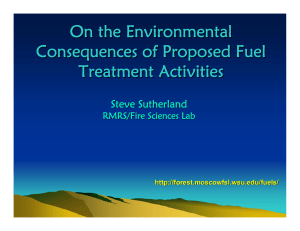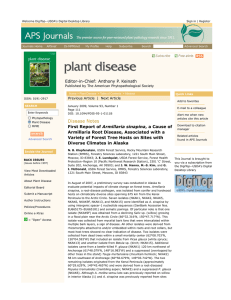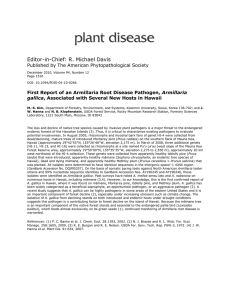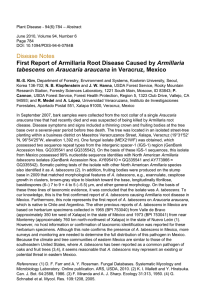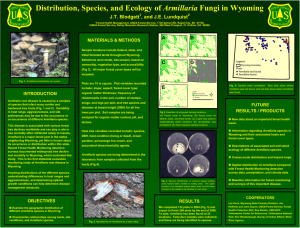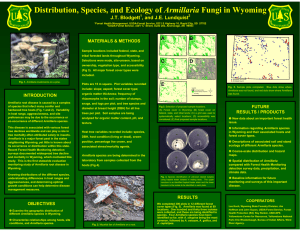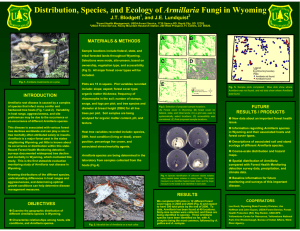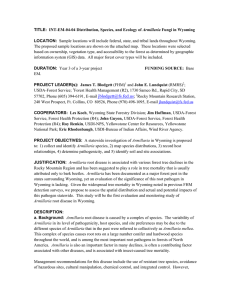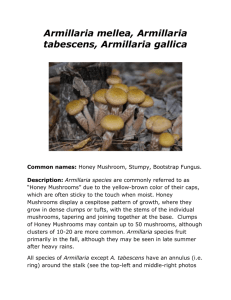Armillaria A Fuels Planning: Science Synthesis and Integration
advertisement
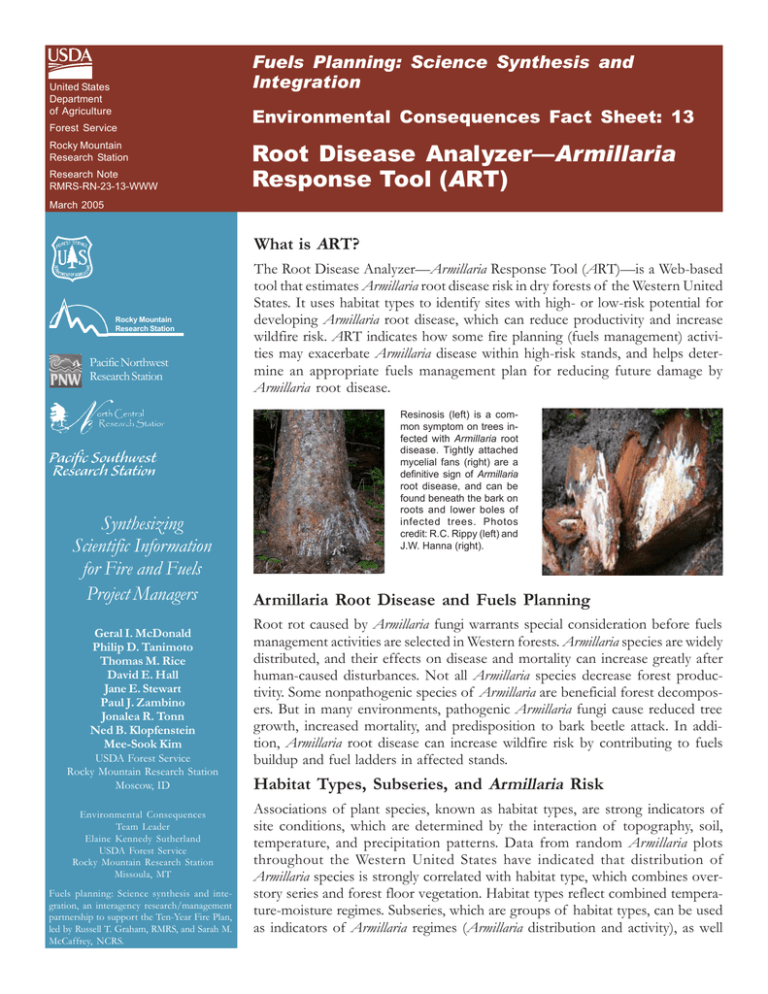
Fuels Planning: Science Synthesis and Integration United States Department of Agriculture Forest Service Rocky Mountain Research Station Research Note RMRS-RN-23-13-WWW Environmental Consequences Fact Sheet: 13 Root Disease Analyzer—Armillaria Response Tool (ART) March 2005 What is ART? Rocky Mountain Research Station Pacific Northwest Research Station Synthesizing Scientific Information for Fire and Fuels Project Managers Geral I. McDonald Philip D. Tanimoto Thomas M. Rice David E. Hall Jane E. Stewart Paul J. Zambino Jonalea R. Tonn Ned B. Klopfenstein Mee-Sook Kim USDA Forest Service Rocky Mountain Research Station Moscow, ID Environmental Consequences Team Leader Elaine Kennedy Sutherland USDA Forest Service Rocky Mountain Research Station Missoula, MT Fuels planning: Science synthesis and integration, an interagency research/management partnership to support the Ten-Year Fire Plan, led by Russell T. Graham, RMRS, and Sarah M. McCaffrey, NCRS. The Root Disease Analyzer—Armillaria Response Tool (ART)—is a Web-based tool that estimates Armillaria root disease risk in dry forests of the Western United States. It uses habitat types to identify sites with high- or low-risk potential for developing Armillaria root disease, which can reduce productivity and increase wildfire risk. ART indicates how some fire planning (fuels management) activities may exacerbate Armillaria disease within high-risk stands, and helps determine an appropriate fuels management plan for reducing future damage by Armillaria root disease. Resinosis (left) is a common symptom on trees infected with Armillaria root disease. Tightly attached mycelial fans (right) are a definitive sign of Armillaria root disease, and can be found beneath the bark on roots and lower boles of infected trees. Photos credit: R.C. Rippy (left) and J.W. Hanna (right). Armillaria Root Disease and Fuels Planning Root rot caused by Armillaria fungi warrants special consideration before fuels management activities are selected in Western forests. Armillaria species are widely distributed, and their effects on disease and mortality can increase greatly after human-caused disturbances. Not all Armillaria species decrease forest productivity. Some nonpathogenic species of Armillaria are beneficial forest decomposers. But in many environments, pathogenic Armillaria fungi cause reduced tree growth, increased mortality, and predisposition to bark beetle attack. In addition, Armillaria root disease can increase wildfire risk by contributing to fuels buildup and fuel ladders in affected stands. Habitat Types, Subseries, and Armillaria Risk Associations of plant species, known as habitat types, are strong indicators of site conditions, which are determined by the interaction of topography, soil, temperature, and precipitation patterns. Data from random Armillaria plots throughout the Western United States have indicated that distribution of Armillaria species is strongly correlated with habitat type, which combines overstory series and forest floor vegetation. Habitat types reflect combined temperature-moisture regimes. Subseries, which are groups of habitat types, can be used as indicators of Armillaria regimes (Armillaria distribution and activity), as well as fire severity and fire return intervals in coniferous forests of the Western United States. Intended Users • • • • Fuels treatment planners Silviculturists Resource managers National Environmental Policy Act (NEPA) planners Intended Uses ART can help reveal stands with site conditions that indicate risk for developing Armillaria root disease, if susceptible host trees are present. It is intended to help users make predictions and evaluate impacts of alternative fuels treatments. Knowledge about the role of fire and responses of various species in Western forests is a good starting point for management considerations. Each fuels-treatment option must be considered in relation to the habitat type, mix of host species, and other interacting factors. ART presents potential effects of fuels treatments for high- and low-risk categories. Treatments included in the tool are: 1. No treatment 2. Thinning 3. Prescribed burning 4. Thinning and prescribed burning 5. Wildfire To assess the effects of fuels treatments on Armillaria root disease, it must be determined whether Armillaria species are likely to exist on the site. As expected, fuels treatments will have no effect on Armillaria root disease for subseries where Armillaria root disease does not occur. Where Armillaria can occur, the decision process is more complex and must consider tree species present, fire regimes, and fuels treatment methods. For More Information The ART model and documentation are available online at:http://forest.moscowfsl.wsu.edu/fuels/art/ ART is currently in the early developmental stage. Required Inputs • Stand location (Forest Service Region or National Forest) • Habitat type • Fuels treatment For effective use of ART, it is essential that stand habitat types have been correctly identified. A GIS-based extension to ART uses landscape analysis to identify misclassified stands and stands with differences in slope and aspect classes that may indicate substands with different habitat types. What the Model Does Outputs include: • Low or high risk for the presence of Armillaria root disease • Potential behaviors after fuels treatments Environmental Consequences Fact Sheets Look for fact sheet topics from the Environmental Consequences Team including information about the effects of fire behavior and alternative treatment strategies, Wildlife Response Model, weed responses, riparian systems, soil erosion, restoration objectives, treated spaces, the Fire Effects Information System (FEIS), and the First Order Fire Effects Model (FOFEM). The habitat type for this stand is grand fir/ninebark-ninebark phase (Abies grandis/Physocarpus malvaceus—Physocarpus malvaceus) (ABGR/ PHMA-PHMA). The Armillaria Response Tool would classify this stand as high risk for the presence of Armillaria root disease. Armillaria root disease causes mortality that can increase fuels buildup and risk of wildfire. Photo credit: R. C. Rippy. Fuels Planning: Synthesis and Integration This fact sheet is one in a series being produced as part of a larger project supported by the USDA Forest Service to synthesize new knowledge and information relevant to fire and fuels management. Fact sheets address topics related to stand structure, environmental impacts, economics, and human responses to these factors. Information in the fact sheets is targeted for the dry forests of the Inland West, but is often applicable across broad regions of the country. For more information, please visit our Web site at: www.fs.fed.us/fire/tech_transfer/synthesis/synthesis_index The Fuels Planning fact sheets are based on preliminary findings. Information from fact sheets will be synthesized in an upcoming publication.
